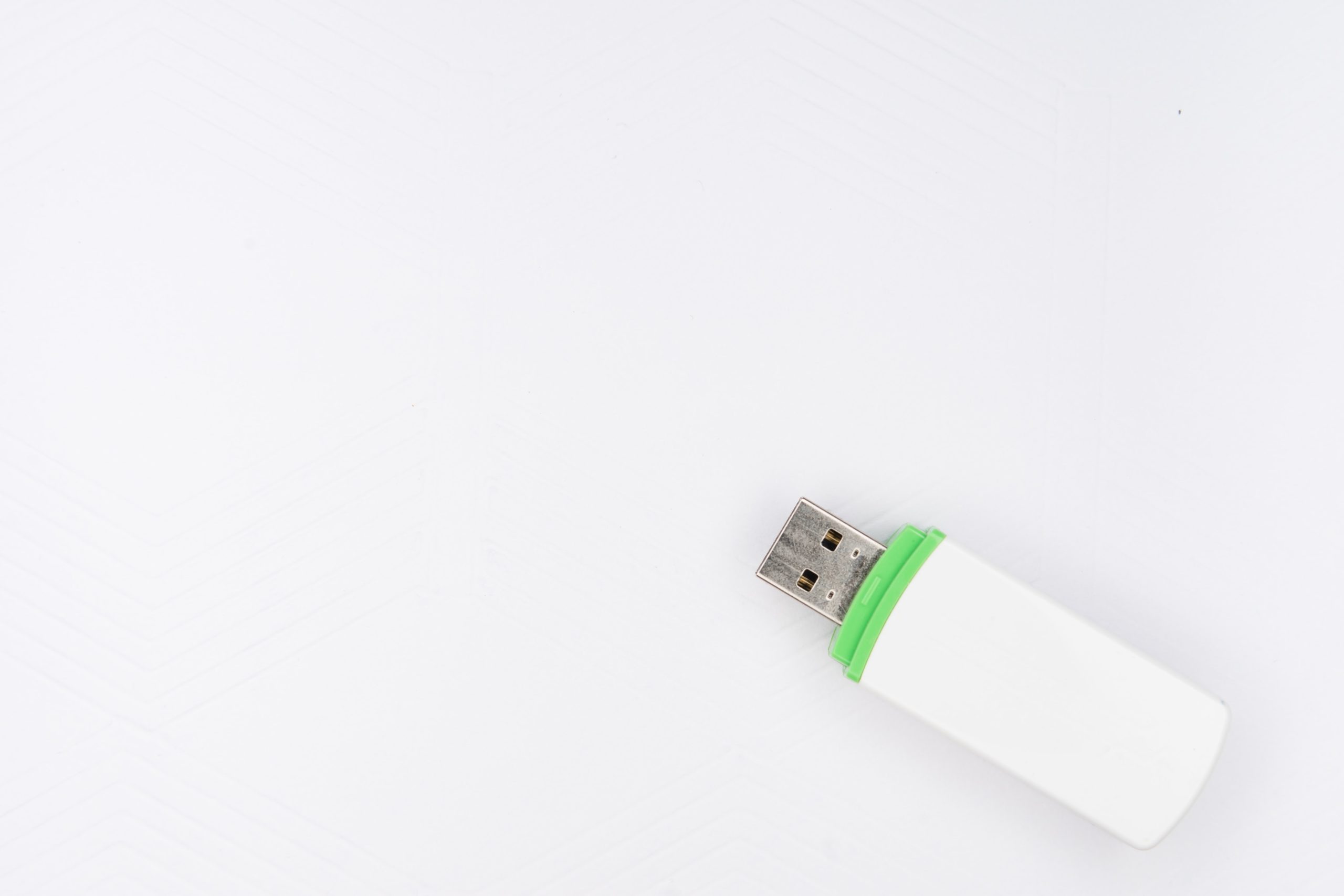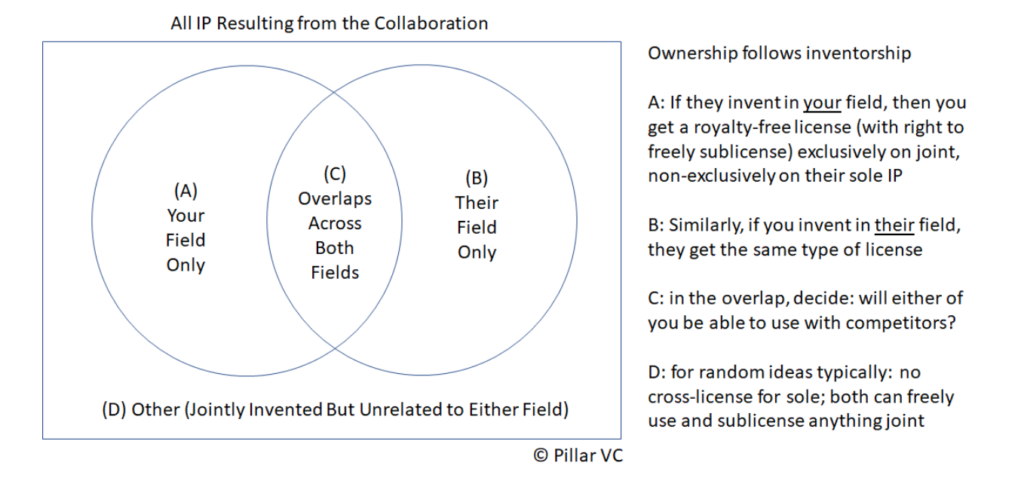Home// Articles// Starting a Company// Part 5: The Gate – Protecting Your IP Outside the Company
Part 5: The Gate - Protecting Your IP Outside the Company
 Russ Wilcox
CEO at Trellis Air
Russ Wilcox
CEO at Trellis Air
Next it is time to venture outside the castle, but you don’t want to let your ideas walk right out the front gate!
Learn how to hold technical or scientific discussions with skilled job candidates and prospective customers and vendors without sacrificing your ability to file and control patents, and find out how best to structure joint development agreements with allies.
Major Contracts that Affect IP
Deep-tech companies must navigate three main types of legal agreements in order to defend against competition and protect intellectual property rights:
📱
Employee & Contractor IP Assignment
🙊
Non-Disclosure Agreements (NDAs)
♺
Material Transfer Agreements (MTAs)
🤝
Joint Development Agreements (JDAs)

Employee and Contractor Assignments
By law a patent is owned by its inventor. The inventor can “assign” his or her ownership rights, typically to his or her employer as a condition of employment, and both the inventor and the assignee company are recorded on the first page of the patent.
So right from day one, you need to require that all employees sign an Employee Proprietary Information and Inventions Agreement before they start work. You can get a version of this from your corporate counsel.
Employee agreements are fairly straightforward but you should double-check a few points before you start using the one your attorney provides. Take care that all intellectual property generated by the employee during the term of employment is assigned to the company, whether or not it was created at work or using company resources, to the full extent permissible by law. Also add a holdover provision so that for six months after employment ends, the employee agrees to assign all right, title, and interest to inventions they make that are a continuation of the work they were doing at the company, and for twelve months they will notify you of any patents they file.
Consulting contracts are more delicate. First, the consultant may be working for multiple companies at a time, so you cannot simply assume you receive assignment of any invention during the term. Second, a contractor who only receives a few thousand dollars may feel it is extremely unfair that they have to assign to you the complete ownership of their glorious patentable invention. Nevertheless, never hire a consultant who gets access to your confidential technical information unless the consultant does sign an IP agreement. Do not rely purely on an NDA because (as explained in some detail below) a standard NDA does not provide for assignment.
Take great care on the definition of the IP that will be assigned from each consulting contract. The standard consulting contract only provides that the consultant must assign inventions conceived or reduced to practice in the course of the engagement i.e. their “work product”. Do not use this language because there are multiple ways it can come back to haunt you. We have experienced:
1.
A consultant admits an invention in your field was conceived while working in the company offices, but declares that there is no obligation to assign because the topic of the invention was outside the project scope.
2.
A consultant admits an invention was conceived during the term of the engagement, however claims it was not conceived while working on the project, but during evenings and weekends.
3.
A consultant hints s/he “might” have conceived of a marvelous idea for solving a problem you face, but demands extra stock options before disclosing it to the company.
The scenarios where a consultant refuses to assign but does reveal the idea are actually worse than if they do not reveal the idea. Now you are “polluted” because you can no longer conceive independently of the invention, which means you cannot confidently file for a patent without including them as a co-inventor (see more on co-inventors below).
In each of these cases if the consultant refuses to assign the patent and you refuse to pay their ransom demand, you have a stand-off. The consultant threatens to file his or her own patent, but you threaten that if that patent contains company confidential information then you will sue them for breach of confidentiality. However, a crafty consultant may decide to wait for your core patents to publish, at which point a lot of company information ceases to be confidential and he or she may be free to file. That extends the dispute for up to 18 months. So basically, you are facing a mess.
Some ways to avoid trouble here are (1) do not rely just on fine print in a contract – actively discuss IP with every consultant in advance and make sure they really understand and do agree upfront to assign any and all IP; pay them enough that they agree this is fair; (2) in the consulting agreement, ensure the scope of the engagement includes, in addition to the specific workplan, an open-ended task to “generally aid and assist the growth and success of the company. identify new business opportunities, and identify new concepts and technologies related to the field of <>” as this serves as a catch-all; and (3) have the assignment clause include any IP related to <> that was conceived or reduced to practice during the term of the engagement, regardless of whether or not it was made at the company or in the course of working billable hours on the project.
Additionally consultants pose the same concerns as employees when it comes to capturing IP that might be conceived shortly after the project ends, and so it is good to add the same 6- and 12-month tail periods on assignment and notice.


Non-Disclosure Agreements (NDAs)
One of the fundamental requirements for protecting intellectual property is to require secrecy from your employees and consultants (generally included as part of the above) and also from all of your vendors, customers, and potential business partners who will have access to your company’s confidential information.
Your company counsel usually provides you with several standard NDAs.
A first version is “one-way” (you will disclose, but not receive information from the other party) and a second version is “two-way” (either side may disclose). You can also get a third version that is “listen-only” and that requires the other party allows you to freely use anything they tell you – this is something you might use if you are concerned that someone you meet could claim you are stealing their ideas. For example, when you send a suggestion to a toy company, they might refuse to look at it unless you first disclaim all right, title, and interest, because if they come out with a similar toy they do not want to be sued by you.
Other major parts of an NDA are: how each side will use the information, the duration of time under which information may be exchanged, whether oral disclosures must be reduced to writing within e.g. 30 days of disclosure, the duration of time for which information will be held confidential, and whether after the agreement ends each side may retain one copy for administrative purposes.
The good point about signing a two-way NDA is that both sides have to live with these terms so they are generally easy to agree. However if your start-up is revealing a lot and the other side is not revealing too much, you may want the permitted uses to be narrow, the disclosure period to continue indefinitely until either party terminates for convenience, any oral disclosures to be automatically included, the duration of confidential time to be unlimited, and no copies kept after the agreement terminates.
It is important that the period of confidentiality is longer than the period of usefulness of the information you will exchange. For example, if you will be showing next season’s fashion colors, one year is sufficient. If you are discussing technical information for which you still have not filed a patent, you could get by with 2 years, since patents publish anyway after 18 months, but you ideally want 5 years because sometimes it takes a while for an invention to become obvious. If you are sharing trade secrets, which need to stay secret perpetually, then the period should be perpetual.
The typical NDA will require both sides to stay silent about secrets, but it does not (nor could it) prevent either side from thinking about the secrets they hear and then conceiving of inventions. And if the other party does file a patent, the typical NDA does not give you any right to own that patent.
Be careful with NDAs — most of them do not protect you from inventions made by the other party.
Early on, E Ink showed its samples to a technology company in Minnesota under NDA. The discussions led nowhere and we thought that was the end of the matter. Eighteen months later we were shocked when we saw patents by that company start to publish in the area of ePaper. (!?) We discovered they had been inspired by the meeting and our youthful enthusiasm to start their own in-house R&D effort based on a parallel type of approach. Thankfully, we had anticipated that idea in one of our patent sprints and we had covered their idea and we had an earlier priority date. They saw that and gracefully shut down their effort. We had dodged a bullet and learned a key lesson – NDAs were less protective than we thought.
There are a few points related to patents that you should always check before signing an NDA: (1) Make sure that any NDA you sign has a provision that the recipient will not use your company’s confidential information “to file a patent”. This is because even though the NDA likely will say that the recipient will not use the confidential information for any purpose other than as agreed, an inventor may argue that filing a patent is not “using” your information, or that a filing with the government is not technically a disclosure to the public. (2) You should also require that the recipient will not attempt to reverse engineer or analyze for composition any physical samples or software you provide. (3) Never sign an NDA that can require you to assign any invention without discussing it first with your attorney. Whenever you see a clause requiring IP assignment in a company’s standard NDA that they send to you, be extremely wary, because it flags that they are savvy and aggressive about patents.
Beyond these points, NDAs are so widely used in business that there are too many aspects to go through here. We recommend that new CEOs ask company counsel to review all NDAs for the first few years, by which point the CEO will develop more expertise. We also warn you that the NDA forms supplied by big companies can be quite aggressive and really get start-ups in trouble. (Amazon and Apple are notorious). Also, be prepared that even though the NDA is just 1-2 pages long, big companies have a backlog in their legal departments for these and so negotiating a reasonable NDA with a corporate giant can take 4+ weeks. The point for now is that you must require an NDA be signed before you hold any discussion that includes technical information, and at the start, you should require that the CEO is the only person in your company who will have the authority to sign NDAs.
If waiting for NDAs is slowing you down, then find a way to hold business meetings without disclosing technical information.
A good principle here is “tell them what your company does, but not how.”
Recently, the US government suggested it may expand technology subject to export control to include biotechnology, AI, and robotics among other fields. This is relevant to all NDAs because communicating confidential information to any foreign citizen is considered an export, even if the person is inside the USA at the time of the conversation. We will know more about which fields are covered in February 2020. In the meantime, you can read about CFIUS and why it may require that your NDA have a special export control notice.
At E Ink, we once had it happen that a job candidate who came for a day of interviews asked a lot of curious questions, and at the end of the day, withdrew from the application process and instead filed their own patent! It was an extremely thoughtful, well-written patent and gave us quite an unpleasant sensation to read. After that, we required all visiting candidates to sign an NDA before meeting our technical team, and the NDA required that they assign to E Ink any inventions that came out of their visit.
Some companies also require that every visitor sign an NDA at reception before being allowed into the building and sometimes they even try to sneak in an assignment clause. This is incredibly annoying but they do it anyway. We know of someone who always signs these “Not Agreed”. Your best bet is just to refuse to sign and offer to meet outside the office instead.
Just because you sign an NDA does NOT mean you should disclose your secrets
The best way to keep something secret is never to disclose it in the first place. Even if well-intentioned, the other company may be hacked, may share information with an employee who later joins your competitor, may just accidentally leave your sample in a subway car. If BigCo blabs your secrets, will you really sue BigCo? It’s unlikely. So even after you sign an NDA, remain tight with your company’s confidential information and make everything “need to know” only.

Material Transfer Agreements (MTAs)
In addition to information, from time to time you may need to share physical samples with another party. Perhaps you will send them a drug candidate, or a cell line, tissues, or a material, or a working device. The issue here is that the other side can use physical samples in unpredictable ways and so you aren’t sure what information will come from them.
Several of Pillar VC’s CEOs are frequent users of MTAs and offer these suggestions:
1.
The MTA should state that both sample and its metadata are confidential.
Metadata can include the sample ID number, name of the sample provider, or other labeling or instructions.
2.
The MTA language should specifically say “may not be reverse engineered or analyzed for composition."
Otherwise you may discover the recipient is using the sample to compete with you.
3.
The MTA should agree in advance whether the results of the recipient’s use/testing are confidential.
At E Ink we had this bite us once… we sent a prototype to a customer for evaluation and it failed one of their acceptance tests. They returned the sample as provided under the MTA. However we did not realize they would start telling other people in the industry “That E Ink stuff doesn’t work.” We fixed the issue in our next version, but the damage to our reputation had already been done. In another case, we had a customer with access to one of our prototypes publish a journal article that showed unflattering data on our ink response times.
4.
You can state in an MTA “recipient may not file a patent application claiming inventions made with use of the sample.”
This will help ensure that if they do invent something worth filing, they discuss it with you. At that point hopefully you can negotiate an IP sharing agreement (see the Joint Development Agreement discussion below).

Joint Development Agreements (JDAs)
Whenever you intend to work with another company to develop new products or technologies, it is wise to sign a Joint Development Agreement (JDA) before you start.
Companies sign JDAs for all kinds of reasons and for both big and small projects. The cooperation can be a limited effort to make a trophy demo together for a trade show where both parties pay their own way, all the way up to an extensive joint product development crusade, where a big customer may pay your company money for milestones that vary by stage.
E Ink did all of these kinds of JDAs:
Proof of Principle
Under controlled conditions, you can show the ability to hit a wow or stretch goal
Proof of Feasibility
At lab scale and with non-production, non-portable electronics, you are making samples that pass extreme acceptance tests, e.g. works at -20C storage
Engineering Sample
You can make 10 units that look like a saleable product, possibly using FPGA instead of ASIC, 3D using pilot-scale manufacturing methods, and they pass every acceptance criteria including drop-test, thermal cycling
Pre-Production Sample
Using factory equipment, you can make 100 units that are ready for sale; and 99 out of 100 pass all incoming inspection and test acceptance criteria
The goal of a JDA project is typically to move your relationship forward one step from where you are.
JDAs take work. Beware of collaborating with corporate headquarters instead of an operating unit. The operating unit seeks technology to ship for volume, whereas someone from headquarters may only want to produce a fancy demo to impress the CEO and get a promotion (or worse, to achieve some dumb internal metric like demos produced).
One of the most complicated parts of a JDA are the sections on IP ownership and cross-license.
The ownership issue starts with procedures for deciding who invented the IP. That can get complicated because each patent can have multiple inventors.
If several people contribute to a patent, even if they just help with a small idea that is the subject of a single issued claim, then they are joint inventors or “co-inventors”.
In the US each co-inventor is considered a full owner of the entire patent. That means any one inventor can sell or license the patent in the US. However outside the USA, while each inventor can practice the invention freely, no co-inventor can grant a license to a third party without the agreement of all inventors.
It can be messy to collaborate with technical people from outside the company.
Even if the patent would be joint, if your business model requires that your start-up be able to sublicense to its contractors for example, the inability to sublicense outside the USA may become a problem.
Inside your company, as long as all the inventors are employees or consultants who assign the invention to you, then the problem is avoided. However, if the inventors come from two or more companies, then we have a real mess on our hands and that mess is resolved in advance by creating provisions in the JDA.
Let’s use an example. Imagine you are a start-up that is developing a new way to make graphene sheets. A radio electronics company wants to jointly develop a graphene antenna with you. This is a new application for graphene and working together you think you could create a breakthrough radio. How should IP be divided?
Most big companies will insist that the JDA should only divide IP that arises in the course of the project. So the first step is to tightly define the project – what activities will each side do? How will each side staff the project? Keep track of this because if either of you invents technology independently of the project, that is not typically covered by the agreement.
For IP that is developed under the project, the ownership principle that most JDAs follow is that “ownership follows inventorship” which means that whichever company invents something is the company that will own the resulting patent. This is called “sole IP”. If employees from both companies co-invented, then both companies co-own that patent, and this is called “joint IP.” A key tip here is to make sure “jointly invented” is defined to include inventions made by one party through reference to the confidential information or samples of the other party.
Ownership determines who will pay the patent and legal fees and who will decide on prosecution questions such as which countries to nationalize. For joint IP both sides need to decide cooperatively how to prosecute, and there will be an extra procedure for what happens if only one party wants to keep paying fees.
Once ownership is clear, the parties then create a cross-license that determines who can use the IP:

For the graphene example, agree to define (A) a field that is purely yours (graphene material), where they will freely license back to you anything they happen to invent (royalty-free dissuades them from trying to invent in your field, but protects you in case they have a lunchtime discussion with one of your scientists and suggest an idea to help with something your scientists are working on), and (B) a field that is purely theirs (radio electronics), where you will do the same for them. Where you both have strong and potentially both collaborative and competitive interest is in (C) the overlap field (using graphene to make better radio antennas) and here you ought to agree on an approach that reflects the degree of your alliance to work together and might range from non-committed to cooperative to exclusive commitment: [C1] overlap inventions are royalty-free in both directions for both sole and joint IP without duty of accounting to each (meaning you can plan to use the overlap IP to work with competitors of the other); or [C2] joint IP is royalty-free, and they agree to license any sole overlap IP to you for a reasonable royalty so that you can also sell graphene antennas to other radio companies and they get some compensation while also enabling you as a field; or maybe they get some warrants or equity instead of a royalty; or [C3] all overlap IP even if invented solely by your company will be exclusive to them (in which case they will be your only future customer in the graphene antenna field, so you better make sure they are paying you a lot up front and you have some escape clauses if they fail to commercialize a product within a reasonable time).
Make sure that each party has an obligation to notify the other if they wish to patent sole IP invention outside their own field.
For example, if you create sole IP resulting from the project that is outside field A, you have to notify the other party of the topic prior to filing a patent. This allows the other party to speak up if they feel they have co-invented and any disputes over ownership can be resolved while memories are fresh rather than 18 months later at publication.
JDAs can take months to negotiate, and the IP issues may give you a headache for the first few contracts. Stick with it though, because they let you collaborate with other leading-edge companies while still protecting your core IP. That means you can innovate faster and more aggressively than your competitors.
Conclusion
With a smart set of contracts in place acting like a gate to guard your interactions with the outside world, you can finally rest content. You have all the elements in place to create an IP fortress. There’s just one topic left to cover – what to do if you are attacked! Learn how to defend your castle in the next section.


